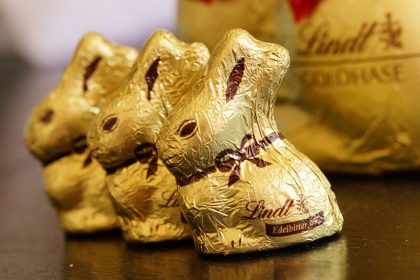Chocolate manufacturer Lindt is successful before the Federal Supreme Court: the gold hue of the Lindt-gold hare has trade validity, the Federal Supreme Court ruled today. An important stage win for trademark protection on the gold colour of the famous Lindt-gold hare – and a contribution to the case law regarding an abstract colour mark as a used mark.
For years: Lindt “Goldhase” as 3 D mark – but in vain

Lindt has been trying to obtain trademark protection for the famous Lindt-gold hare for many years. For years, the company initially tried to obtain trademark protection as a 3-D trademark, but Lindt failed in all instances, a process that was taken all the way to the European Court of Justice (ECJ). The elements of the trademark applied for (shape, gold foil and red ribbon with little bells) would not give the trademark the necessary distinctive character, it was decided with regard to the 3 D trademark sought – more than 10 years ago.
Lindt Sprüngli then changed its protection strategy. The Swiss chocolate manufacturer now sought to have the colour gold in the Lindt Gold Bunny (colour: CIELAB 86.17, 1.56, 41.82) registered as a colour mark under German trademark protection. The gold shade in the Lindt Gold Bunny was protectable as a used mark, as evidenced by a traffic survey which attested to the Lindt Gold Bunny’s widespread recognition. At first instance, the Munich Regional Court had found this argument conclusive.
Decision of the OLG Munich
But the OLG Munich ruled against the colour mark for the Lindt-gold hare. The OLG Munich had found that the plaintiffs Lindt Sprüngli were not the owners of a use mark under § 4 No. 2 MarkenG on the golden colour of the ‘Lindt Gold Bunny’. The necessary reputation was lacking.
In the past, when case law has confirmed that an abstract colour mark has acquired distinctiveness, it has always been in cases where companies use a certain colour as the “house colour” for their goods or services. Famous examples are Sparkasse red and Nivea blue.
Lindt Sprüngli, however, used the gold colour for a specific product, namely the Lindt-gold hare. However, the OLG had ruled that the colour had not acquired a reputation for the chocolate bunny product. According to the OLG, a consumer would not associate a bunny wrapped in similar gold foil, which otherwise looked completely different from the Lindt Gold Bunny, with the “Lindt company”, as he was familiar with the real Lindt-gold hare. Lindt Sprüngli appealed against this decision.
BGH: Lindt-gold hare has trade connotation
And the Federal Supreme Court ruled the opposite (I ZR 139/20). The case was already heard in May 2021 – we reported – and today the BGH published its decision in a press release. According to the Supreme Court, the plaintiffs Lindt Sprüngli successfully proved that the golden hue of the Lindt-gold hare has acquired a reputation as a trademark for chocolate bunnies within the relevant public within the meaning of § 4 No. 2 MarkenG.
In fact, the “Lindt Gold Bunny” is by far the best-selling chocolate Easter bunny in Germany. Its market share in Germany in 2017 was over 40%. And according to a traffic survey submitted by the applicants, 70% of respondents attribute the golden hue used for the foil of the Lindt-gold hare to the applicants’ company in connection with chocolate bunnies.
This result clearly exceeded the required threshold of 50%, the BGH emphasised. Contrary to what the OLG Munich had argued, the acquisition of reputation does not require that the colour mark is used as a “house colour” for all or numerous products of the company, the BGH stated. The court added that other design elements (bells, red ribbon) did not affect the reputation. Rather, it was decisive that the consumers addressed would see an indication of origin in the use of this shade of gold for chocolate bunnies even if it was used together with these other design elements.
In addition, the BGH contradicted the judgement of the OLG Munich on a further point, stating that it was in no way relevant whether consumers would see a reference to the origin of the Lindt Gold Bunny if the shade of gold was used for chocolate bunnies other than the well-known Lindt Gold Bunny. This aspect only comes into play in the case of an action on the grounds of likelihood of confusion.
Lindt Sprüngli’s action was therefore upheld in its entirety. The BGH referred the case back to the Court of Appeal for a new hearing and decision. There, it was to be examined whether the defendant had infringed the plaintiffs’ used mark on the gold shade of the Lindt-gold hare by distributing their chocolate bunnies, which are also packaged in gold-coloured foil. The Lindt-gold hare will therefore continue to occupy the courts – in any case, Lindt Sprüngli achieved an important success before the Federal Supreme Court today.
Protect or defend a trademark? We are happy to help!
Our attorneys have many years of expertise in trade mark law as well as in the entire field of intellectual property and are entitled to represent you before any court – in Germany and also internationally.
Please feel free to contact us if you are interested.

Sources:
BGH press release, I ZR 139/20
Image:
Ephraimstochter | pixabay | CCO License







Leave a Reply